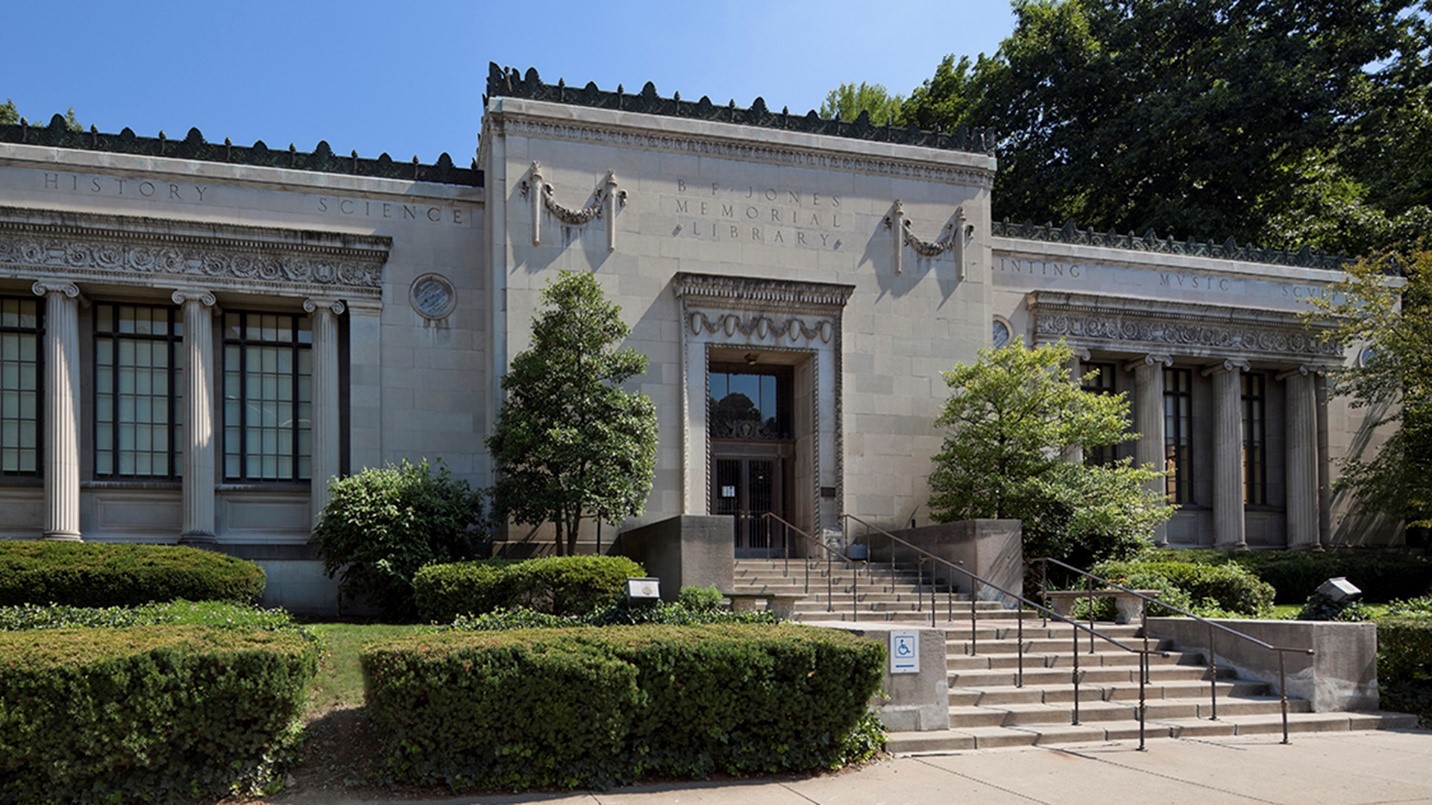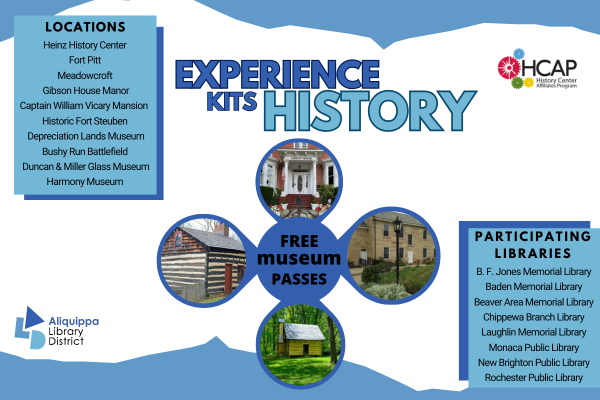B.F. Jones Memorial Library - Aliquippa, PA
B.F. Jones Memorial Library - Aliquippa, PA
663 Franklin Avenue
Aliquippa, PA 15001
Telephone: (724) 375-2900
Fax: (724) 375-3274
Director: Kristen Janci

| Hours | |
|---|---|
| Monday | 9:00 AM - 7:30 PM |
| Tuesday | 9:00 AM - 7:30 PM |
| Wednesday | 9:00 AM - 7:30 PM |
| Thursday | 9:00 AM - 5:00 PM |
| Friday | 9:00 AM - 5:00 PM |
| Saturday | 9:00 AM - 5:00 PM |
| Sunday | Closed |
Upcoming days closed:
Board Meetings
Board meetings are held the Third Thursday of each month at 5pm.
B. F. Jones Memorial Library - Architecture
The B. F. Jones Memorial Library was built in 1928 in the town of Woodlawn in Beaver County, on the Ohio River, twenty miles northwest of Pittsburgh. Woodlawn was later re-named Aliquippa and developed as the company town for the Jones and Laughlin Steel Company. Mrs. Elisabeth Horne, daughter of steel magnate and company founder Benjamin Franklin Jones, built the Library in memory of her father. Mrs. Horne purchased ten parcels of land and engaged the services of the architectural firm of Bartholomew & Smith of Pittsburgh. She worked closely with architect Brandon Smith, especially in the selection of the interior/exterior materials, lighting, and landscaping. The B.F. Jones Memorial Library was opened to the public on February 1, 1929.
The Italian-Renaissance-style building is a one-story, 15,000-square-foot structure, measuring 132 x 72 feet, with the long elevation facing Franklin Avenue. The general massing of the building is very heavy. The limestone facade is flat and gives the visual impression of a very stable, formal building in which important events occur. The building's exterior is constructed of grey Indiana limestone. The roof line is decorated with an elaborate cast bronze cheneau. Carved in the wall face below the cheneau are the words: Philosophy, Biology, Astronomy, Fiction, History, Science, Painting, Music, Sculpture, Drama, Poetry, and Romance. The exterior doors are constructed of bronze, with a decorative bronze gate across their glazed openings. The name B. F. Jones Memorial Library is carved above the doorway and is flanked by carved fasces and drape.
The principal ornamentation of the two front facades consists of four Ionic columns forming a recessed colonnade. The entablatures above them are decorated with elaborate spiral carvings. Three large 6x13-foot bronze-frame windows are found behind the recessed columns on the front elevation. Flanking each set of windows are carved stone medallions measuring more than 3 feet in diameter. Additional triple windows are located on the side elevations.
In the major interior spaces of the building, travertine was used on the floors and on some of the walls. Kosada marble and plaster were also used on the walls. The Library's interior design was coordinated by color architect Norah Thomas of New York. The intricate ornamental plaster ceilings were designed by Ms. Thomas and set by craftsmen from the Joseph Horne Company. The interior doors are of solid mahogany and brass.
The foyer of the building is dominated by a larger-than-life size statue of Benjamin Franklin Jones. This bronze sculpture rests upon a base of green Vermont marble. It is the work of Robert Aiken, a celebrated New York City artist. The ceiling of the foyer is a reproduction of an Italian ceiling constructed of elaborate ornamental plaster. The foyer is separated from the central lobby by three glass-filled colonnade arches, through two of which are glass and bronze doors. A quotation from Sir Francis Bacon is engraved on the foyer wall.
The Lobby boasts a 196-pane skylight over the Library's Main Desk. The ceiling and crown molding are of exquisite ornamental plaster. The molding is decorated with marble medallions designed to represent the molten steel which built this town and its Library. Kasoda marble adorns the walls and pillars of this magnificent space. The pillars are topped with Cretan stone carved in the Norman Renaissance tradition. The mezzanine and book stacks are located behind the Lobby.
The entrances to the Reading and Reference Rooms on opposite sides of the Main Desk are marked with stately bronze and iron gates which were designed and created by German-American metal craftsman, Oscar Bruno Bach, who also created the famous inlaid steel mural in the lobby of the Empire State Building. The Library's gates are reminiscent of altar screens from European cathedrals.
The ceiling in the Reading Room is made of decorative high-relief ornamental plaster in the Renaissance style. Marble medallions decorate the Reading Room walls, echoing the molten steel design from the Library's Lobby. A portrait of Benjamin Franklin Jones from 1890 is displayed here. A carved stone doorway leads from the Reading Room to the Library's Archives and elevator.
The Reference Room was originally designed as the Children's Reading Room and decorated with children's themes. The plaster walls feature polychrome terra cotta medallions, copies of the famous Andrea della Robbia Bambini from the porch of the Foundling Hospital in Florence, Italy. The Reference Room also features a cherub-and-goose sculpture in the della Robbia colors, originally designed as a water fountain. The ceiling is plaster molded to simulate wooden beams and painted to represent gum wood, with a lovely stenciled floral pattern. The frieze and metal work in this room are decorated with cherubs and children at play. A portrait of the donor, Mrs. Elisabeth McMasters Jones Horne, by Dutch painter Alfred Hoen, is displayed here.
The doorway into the original Children's Story Hour Room, now the Library's Director's Office, is made of stone cast from marble chips and carved according to the architect's design. A frieze of cherubs has been added to the classic Florentine design. A meeting space adjacent to the doorway offers a view of the Library's lovely garden.
The Director's Office is home to the Library's magnificent leaded glass window featuring ten stained glass medallions of Mother Goose nursery rhymes, the work of artist Henry Hunt of Pittsburgh. The window was refurbished in 2011 to recover its original grandeur and preserve it for the future. The Director's Office also boasts a great conical Renaissance fireplace, an elaborate plaster cast crown molding, and a terra cotta tile floor with insets of antique design.
The lower level of the building, now the Children's Library, is accessible from the foyer by means of a spiral stone staircase decorated with Italianate bronze panels and brass handrails. The Lobby on the lower level features a frieze of vivid polychrome Doric decoration in primary colors. The two public rooms which were originally designed as an exhibition hall and gallery have been transformed into stimulating and inviting spaces for children. A fascinating light sculpture in the shape of an open book dominates the Children's Reading Room. The Picture Book Room features a collection of framed lithograph posters illustrated by F. L. Warren and published by the National Child Welfare Association, circa 1920.
In recognition of its outstanding architecture, the library building is listed in the Pennsylvania Inventory of Historic Places and the National Register of Historic Places. The lower level and mezzanine are accessible by stairs and by elevator from the Library's handicapped entrance.
August, 2013

.png)